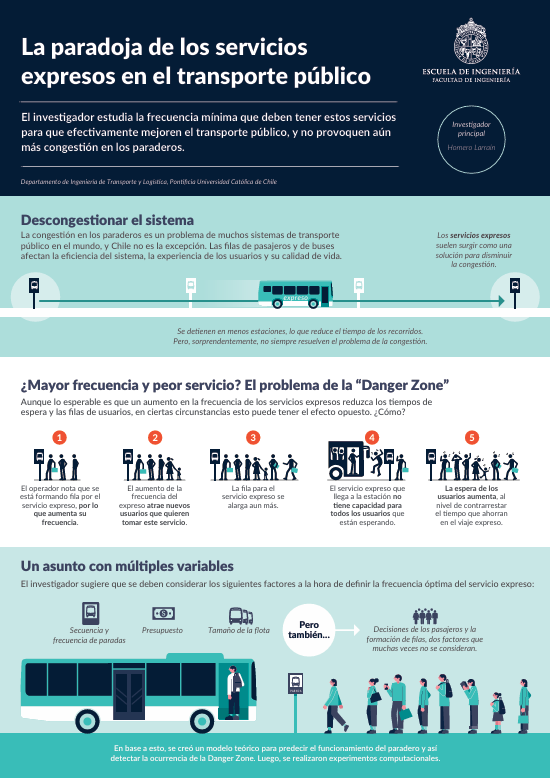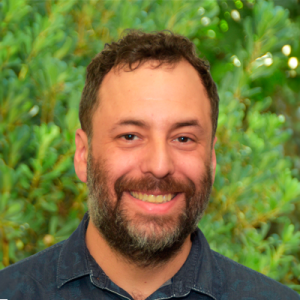Department of Transport and Logistics Engineering

Portada » Optimizing express services to reduce congestion in public transportation

Department of Transport and Logistics Engineering
The quality of a city’s public transportation is often directly related to the quality of life of its residents. The better the system functions, the less congestion there will be on the streets, and therefore, shorter travel times. Moreover, with an efficient public transportation system, residents will more likely choose buses or the subway instead of using their own cars, which undoubtedly contributes to more sustainable cities.
When designing a plan to reduce passenger congestion at bus stops, one solution that seems intuitively correct is to introduce express bus services into the system. For example, if a route has stops A-B-C-D-E-F-G, the express service would only stop at select points, such as A, D, G, thus taking less time to complete the route for those destinations. Therefore, for a passenger traveling from A to G, the express service – in theory – would considerably reduce travel times.
However, Professor Homero Larraín, from the Department of Transport and Logistics Engineering, has developed a study that identifies a paradox: in certain scenarios, introducing express bus services to the system can increase passengers’ travel time. How is this possible?
Increasing the frequency of express services is likely to boost demand, leading to longer queues at the bus stops. As a result, express buses might not be able to pick up all the waiting passengers on arrival.
Thus, if express buses are not scheduled appropriately, waiting times could offset the time saved by using the service. In such cases, adding express buses would actually increase congestion, a phenomenon identified by researchers as the ‘Danger zone.’
The study of this phenomenon revealed that the following factors should be considered to define optimal frequencies for an express service:
Since this last factor is often overlooked, Prof. Larraín developed a theoretical model and computational experiments that incorporate passenger decisions and queue dynamics to answer the following question: How can the frequency of an express service be optimized to prevent the Danger Zone?
The theoretical model considered a generic scenario: bus stops available to both services, with one queue for buses that stop at every station – “local buses” – and another one for express buses. The model considers a group of “flexible” passengers that can choose either service, as both stop at their destination.
Using queuing theory, which studies the behavior of waiting lines and aims to optimize the flow of systems, the researcher defined two express bus frequencies that would be key to identifying and avoiding the Danger Zone.
Frequency F1 refers to the point at which it makes sense for a passenger to wait for the express bus, considering the time saved by reaching their destination faster. The second key frequency, F2, is the one that allows the express buses to absorb the demand from all flexible passengers. The Danger Zone, therefore, occurs when F1 < F2, a situation where waiting times at the bus stop become long enough to outweigh the time saved by bypassing non-express stops.
Department of Transport and Logistics Engineering

After completing this theoretical model, Prof. Larraín conducted computational experiments with different frequency combinations, this time incorporating a “User Behavior Model.” This model is based on the premise that users will choose or switch to the line they believe will minimize their travel time and is supported by two sub-models. The first sub-model focuses on the information passengers have about the frequency of the express buses, with options for either “perfect” information (e.g. a mobile app showing real-time bus locations) or “imperfect” information (passengers only know the frequency, bus capacity, and line length). The second sub-model examines whether passengers decide to switch lines when the long-distance bus passes and shortens the line.
The computational experiments confirmed the effectiveness of the theoretical model in defining the parameters of the Danger Zone, which occur when F1 < F2. Furthermore, the experiments revealed that introducing a degree of randomness into passengers’ decision-making reduces the effects of the Danger Zone.
In contrast, these effects are amplified when passengers have perfect information; the Danger Zone starts earlier, and the lines grow longer compared to when passengers only have imperfect information.
Homero Larraín highlights that the future directions of this research involve integrating transportation networks with various service modes and conducting field studies, including interviews and line measurements. However, one conclusion he can already confidently state is that it is crucial to consider behavioral models and phenomena like the Danger Zone because, in some cases, a policy that appears to address a problem may, in fact, make it worse.

Department of Transport and Logistics Engineering